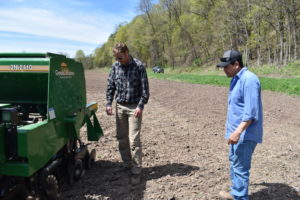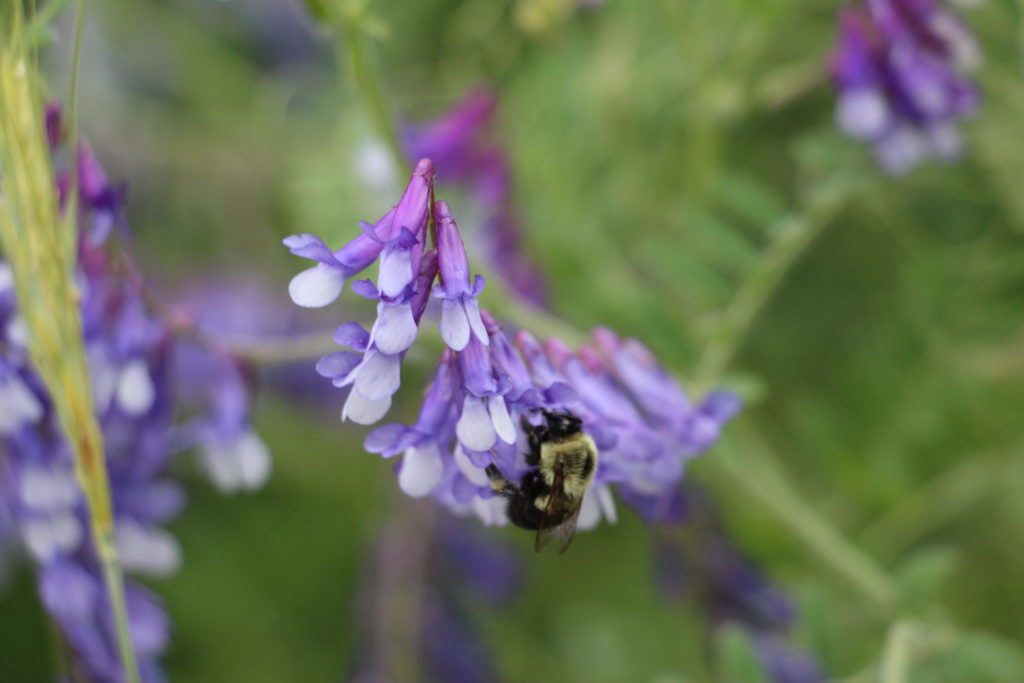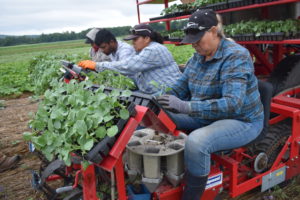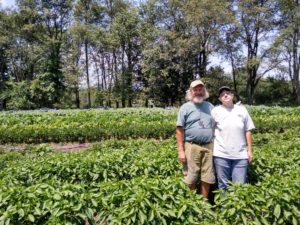Leer en Español
Growers experiment with minimum to no-till to enhance soil health
“The soil is the great connector of lives, the source and destination of all. It is the healer and restorer and resurrector, by which disease passes into health, age into youth, death into life. Without proper care for it we can have no community, because without proper care for it we can have no life,” — Wendell Berry, The Unsettling of America: Culture and Agriculture
On a spring day the sun is shining and it is all blue skies in Hurley. At the helm of the tractor is Jesus Gonzalez, a Hudson Valley Farm Hub field crops team member, who is working his way through the near 200 acres that border Route 209. Gonzalez’s goal is to plant a layer of cover crops – red clover and oats.

The coulters on the drill loosen the soil, and the double disc opener drops the seed in the trench. The cover crop, once established, will provide ground cover to keep weeds at bay while adding nutrients to the soil in preparation for next year’s grain corn. This is one example of the farm’s efforts to reduce tillage and in doing so, boost soil health.
Tilling — the practice of digging, overturning or stirring soil to prepare it for a new planting of crops — is a norm in farming. While it is primarily used as a tool for weed management, excessive tillage disturbs the soil (in other words – disrupts the soil balance) and can lead to a decline in organic matter and soil that is more vulnerable to water and wind erosion. Tillage also contributes to soil compaction, which can lead to water run off.
To be sure, there is rising concern amongst growers across the country over soil health, and the loss of fertile land. This is fueled in part by extreme weather such as flooding and wild temperature fluctuations.
To address soil health, the Farm Hub is one of a growing number of farms in the country practicing minimum tillage and exploring no-till (commonly referred to as no-till). The idea is to promote soil biodiversity, generating more of the carbon needed for fungi and bacteria critical to soil livelihood and ultimately adopt more ecologically resilient ways of farming.
The key terms are defined as follows:
- Reduced tillage – using equipment only when it is necessary, and only using equipment that non-aggressively disturbs (other words – breaks apart, loosens) the soil, and gets an efficient kill. An example of this is vertical tillage.
- Minimum tillage (sometimes called rotational no-till) – this can include a crop rotation that doesn’t require tillage and or using equipment such as a roller/crimper, a piece of equipment attached to a tractor that flattens cover crops, leaving them to transform into mulch that kills weeds.
- No-till – no tilling involved at all. This uses a variety of methods to seed the crop into the soil and utilize equipment such as the broad fork to loosen the soil before planting.
Alternative methods
For organic growers who do not spray herbicides, the key is to engage in alternative strategies in weed management including crop rotation and using minimum tillage tools or no-till equipment. Another way to control weeds is to plant perennials such as clover and alfalfa. Addition of livestock is another approach that has been noted to have various benefits.
Cover cropping is also considered one of the most effective ways to achieve healthy soil without tilling. The key to success is timing, says Emmanuel Omondi, director of the farming systems trial at Rodale Institute.
“They say timing is everything and you need to terminate the cover crop at the right time. If you terminate too late then it goes into seed,” he says.
Growers agree that benefits include:
- Supporting more of the carbon needed for fungi and bacteria critical to soil vitality
- Reducing soil compaction, which allows fungi, bacteria and earthworms and roots to move more naturally and freely
- Attracting earthworms and other beneficials that naturally help break up the soil
- Reducing tillage that can eventually save time and fuel costs by eliminating steps such as plowing and discing, and going straight into seeding
2019 growing season
Over the past several years, the Farm Hub has been practicing minimum till with the idea that no-till farming will be the preferred approach for the majority of the farm in the future. In the long run “we hope to be no till as much as possible,” says Farm Manager Eddie Clevenger. “For us it is about regenerating the soil. This is a long-term investment and not something we are going to do overnight,” he says.
Field crops
With the 2019 growing season in full swing, the field crops team moves forward with 200 acres of no-till fields out of a total of 450 acres of cover crops. The team designed a four-year crop rotation, which involves a mix of cover crops and cash crops.

Off Route 209 between Kingston and Hurley, a passerby will catch a glimpse of a field of cover crops that are building the soil for next year’s organic grain corn crop. The crew planted a blend of oats and red clover in the southern half of the field; as of late July the oats were mowed and the clover will be diced up next spring to ready it for the corn. The northern half of the field is a medley of 14 species of cover crops, which include a six-way spring mix (oats, peas, phacelia, sugar beet, kale, and faba bean) that was rolled and crimped in late June. This was followed by the seeding of an eight-way summer mix of Sorghum Sudan grass, Sunn hemp, sunflower, buckwheat, cowpea, teff, radish, and turnip.
The mix was carefully chosen based on its value as a cover crop. Legumes such as faba beans and peas bring in much needed nitrogen. Kale and sugar beets add diversity. The team also made their decisions based on past experience, research, and information gleaned at conferences and workshops they attended in the past. Other Farm Hub staff contributed as well. Andrew Casner, a grower and member of the Farm Hub’s ProFarmer Training Program, recommended stepping up the number of varieties for diversification and promoting an active bacterial and fungal exchange beneath the surface.
“We wanted a diverse mix to create soil health and we’re experimenting with creating a diverse multi-species mix out there in the field, trying to imitate what naturally happens out in a native pasture,”says Jay Goldmark, field crops manager.
This year’s plan also included a no-till planting of a 120-acres of soybeans into roll and crimped rye. A no-till drill and roller/crimper implement designed for no-till farming were in the process. As of mid-June, success could be seen with straight rows of emerald-colored soybeans surfacing through a field of flattened rye into which they had been planted. Soy beans and rye are good companions, with the rye suppressing weeds.
With the goal of growing no-till corn, there is a separate experiment that examines the economics of no-till corn and monitors net profit and crop yield. This involves planting corn into vetch and cereal grains. The team established the cover crop on five acres the previous fall: vetch, oats and peas. Vetch can be an important player in no-till corn and feeding the corn with much-needed nitrogen.

The downside, however to pairing vetch with corn is the timing. Because the vetch has to be terminated at the just the right moment before it starts to set seed, the roll and crimp happens late in the corn planting window which generally results in lower yield. This year, in order to allow for the cover cropping and resulting shortened time-frame, the field crops team chose an 88-day corn variety instead of one of the more typical 95 to 107-day varieties. In June, the team terminated the vetch by running the no-till drill coulters through the ground, and then used a no-till corn planter to seed the corn into the vetch.
Vegetables
At the Farm Hub the move toward minimum tillage for both field crops and vegetables occurred at the beginning of 2016, a year which saw heavy rainfall.
Jean-Paul Courtens, an organic grower in New York who previously worked at the Farm Hub, and the Farm Hub’s ProFarmers began exploring the use of legumes mixed with cereal grain cover crops such as winter rye, vetch and Austrian winter peas by rolling and crimping on land they divided into tilled versus untilled soil. They incorporated the no-till transplanter — a machine commonly used by tobacco growers for no-till — and learned that it required some modifications to avoid the cover crop residue clogging the machine. They found untilled soil had better water holding capacity and structure, and held visible signs of health including the presence of bountiful earthworms. They experimented with rotational no-till vegetables and field crops, and for the first time used the no-till transplanter on vegetables. The process has been refined through trial and error; one improvement involves alternating certain machines such as the no-till transplanter to strive for less soil disturbance.
Since then the Farm Hub has continued to experiment with no-till methods. In the 2019 growing season, roughly 2.5 acres of the Farm Hub’s 25 acres of vegetable production is allotted for no-till farming. Among the staple vegetables, no-till vegetables include green beans, sweet corn, broccoli and winter squash.

Jeff Arnold, vegetable production manager, explains that the vegetables that were already transplanted were selected for no-till. Green beans are a good fit as they can easily push their way through three inches of mulch. The vegetable production team is refining the equipment used in the field as well. The no-till transplanter, for example, has the function of cutting through the mulch to create a trench, drop the plant in, and close the trench. In 2018 the equipment had mixed results so modifications were required; the team replaced the wavy coulters with straight coulters “that would slice right through between the rye plants and it won’t make that wide trench.”
This year Arnold and his crew hand-planted a number of the vegetables such as winter squash, but also used the modified no-till transplanter with vegetables such as sweet corn and broccoli.
The Big Picture
The plan is to continue refining no-till strategies. While too early to forecast the end results, Clevenger notes there are already noticeable differences in the soil. Based on data from regular soil monitoring, the Farmscape Ecology team has reported soil quality improvement, and the farmers have seen a growing population of earthworms.

On a recent weekday in late June, Goldmark drove out to the field where the six-way mix of cover crops had grown out. Under bright sun and blue skies, white butterflies fluttered and insects took flight among the mosaic of cowpeas, kale, and phacelia, marked by spiky phacelia flowers. From a distance, a Great Egret walked gingerly across water, at times stopping to soak up the sun. The bounty of butterflies, bees, and earthworms were a sign of soil vitality.
This field, which has not been tilled since 2017, has undergone a slow and steady transformation from what it once was. There are signs that farming and wildlife are moving towards a balance, which involves the delicate art of sharing the land. Since no-till started, the land has yielded fall rye, no-till soybeans, the six-way cover crop mix and in the future, a summer mix of cover crops followed by corn.
While experimentation continues and is ever-evolving, the spotlight is always on the soil.
“Most important is not breaking up the soil structure. We’d like to keep something growing on the land at all times. If you don’t grow crops then weeds grow,” Clevenger says. Critical too is a switch in mentality, says Clevenger. “You have to totally rethink the way you are doing things,” he points out. Ultimately at the Farm Hub, he says, the journey from tillage to no-till is one of knowledge exchange and communicating what has been tried and tested with a larger community.
-Amy Wu
Click here for Q&A with soil microbiologist Kris Nichols
HUDSON VALLEY GROWERS
In practicing minimum tillage or achieving no-till a goal that many growers aspire to from the standpoint of sustainability. Ben Dobson, farm manager at Stone House Farm in Hudson, NY, has been transitioning the farm from conventional no-till to organic no-till since 2014. The farm, which encompasses 2,000 acres of grains and perennials, practices minimum tillage and no-till through methods such as rolling and crimping and using a no-till planter. To boost no-till practices, Dobson also incorporates livestock, specifically cattle and sheep, to assist with manure application. Dobson says he has seen tangible results from no-till practices.
“The major benefit is of building soil organic matter, our input costs are generally reduced, we don’t use any chemicals,” he says. “We’d love to be totally no-till, but we rotate perennials through the farm to kill weeds and we do plow those under the ground.” He adds that major challenges to attaining no-till are weed management and data collection.

About an hour south of Hudson in Gardiner, grower Jay Armour and his wife mark 18 years and counting of practicing no-till farming at Four Winds Farm. The farm has a diversified crop across four acres including heirloom tomatoes and lettuce. The impetus to go no-till started 23 years ago when the farm had significant weed problems. The couple met Lee Reich the author of “Weedless Gardening,” who recommended they stop tilling and tackle the weed problem by using compost. Armour says most effective has been the compost layer (the farm now makes their own), and manure from the farm’s cows.
“We set out doing no-till as a way of weed control and it helped tremendously, but we didn’t realize we were building organic matter in soil. We stopped tilling and we lay compost on top of growing area and that way we can control the weeds. In the first couple of years we had a lot fewer weeds, and there was no turning back at that point,” he recalls. Tests show the soil organic matter has hovered between 8 percent to 10 percent over the past eight years, and the soil appears to stay moist during the dry periods.
Armour observes the plants appear to be healthier. “For us, it was a gradual change, we didn’t realize what was happening and now we sort of take it for granted,” he says.
-Amy Wu
RESOURCE SECTION
For more information explore the following sources.
The Rodale Institute
Cornell Cooperative Extension
Penn State Extension
Conservation Agriculture Movement
National No-Tillage Conference
“The Organic No-Till Revolution: Growing for Market” by Andrew Mefferd
“Organic No-Till Farming” by Jeff Moyer
“The Carbon Farming Solution” by Eric Toensmeier
“Building Soils for Better Crops” by Fred Magdoff and Harold van Es
“Dirt to Soil: One Family’s Journey Into Regenerative Agriculture” by Gabe Brown
“Weedless Gardening” by Lee Reich
